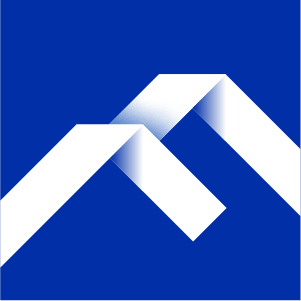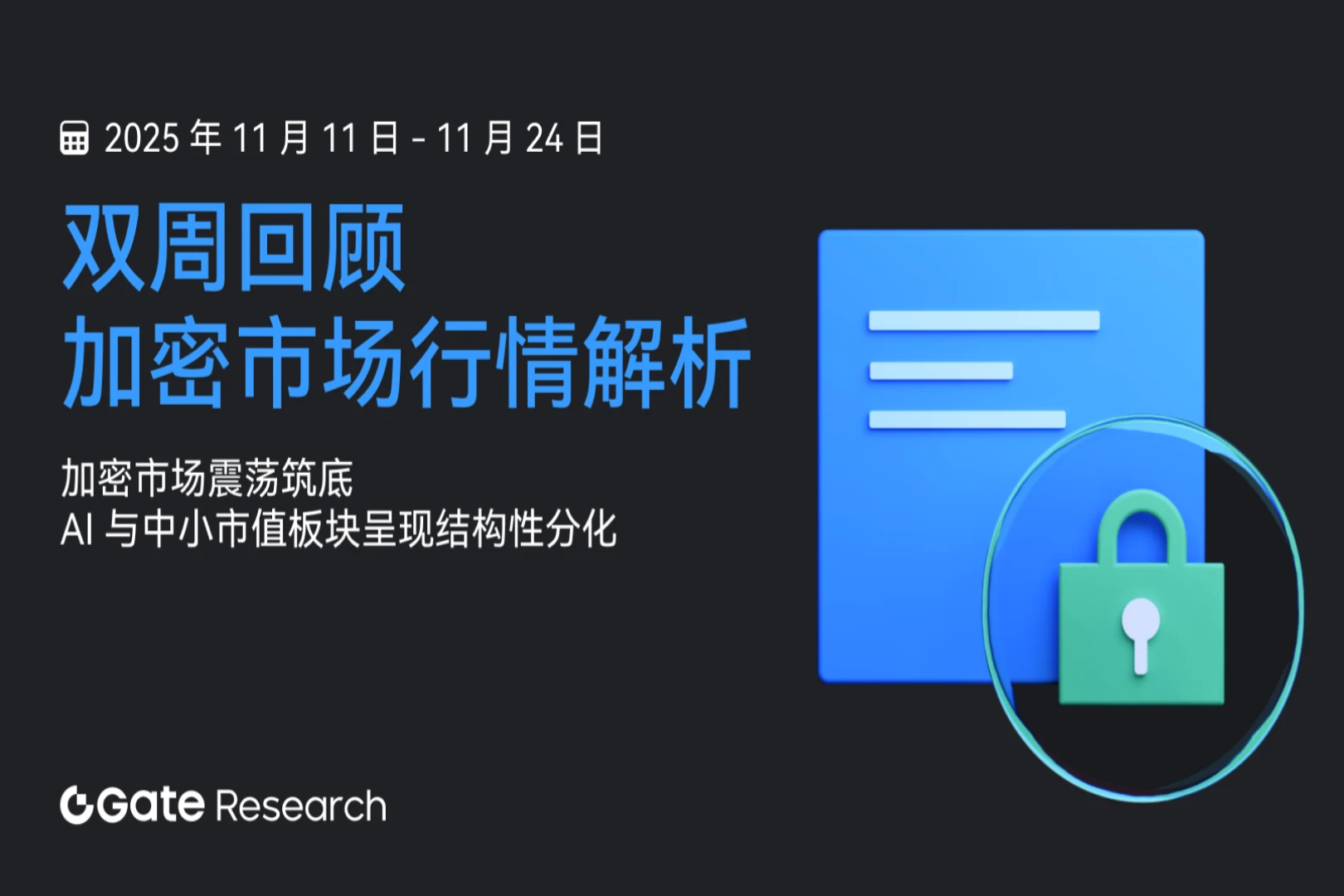A New Starting Point of 350 Million: Arbitrum's RWA Ecosystem Blueprint and Wealth Code
- 核心观点:Arbitrum成为RWA增长最快的L2解决方案。
- 关键要素:
- Arbitrum RWA TVL超3.5亿美元。
- STEP计划推动机构级资产上链。
- Franklin Templeton等传统机构入驻。
- 市场影响:加速传统金融资产链上化进程。
- 时效性标注:中期影响。
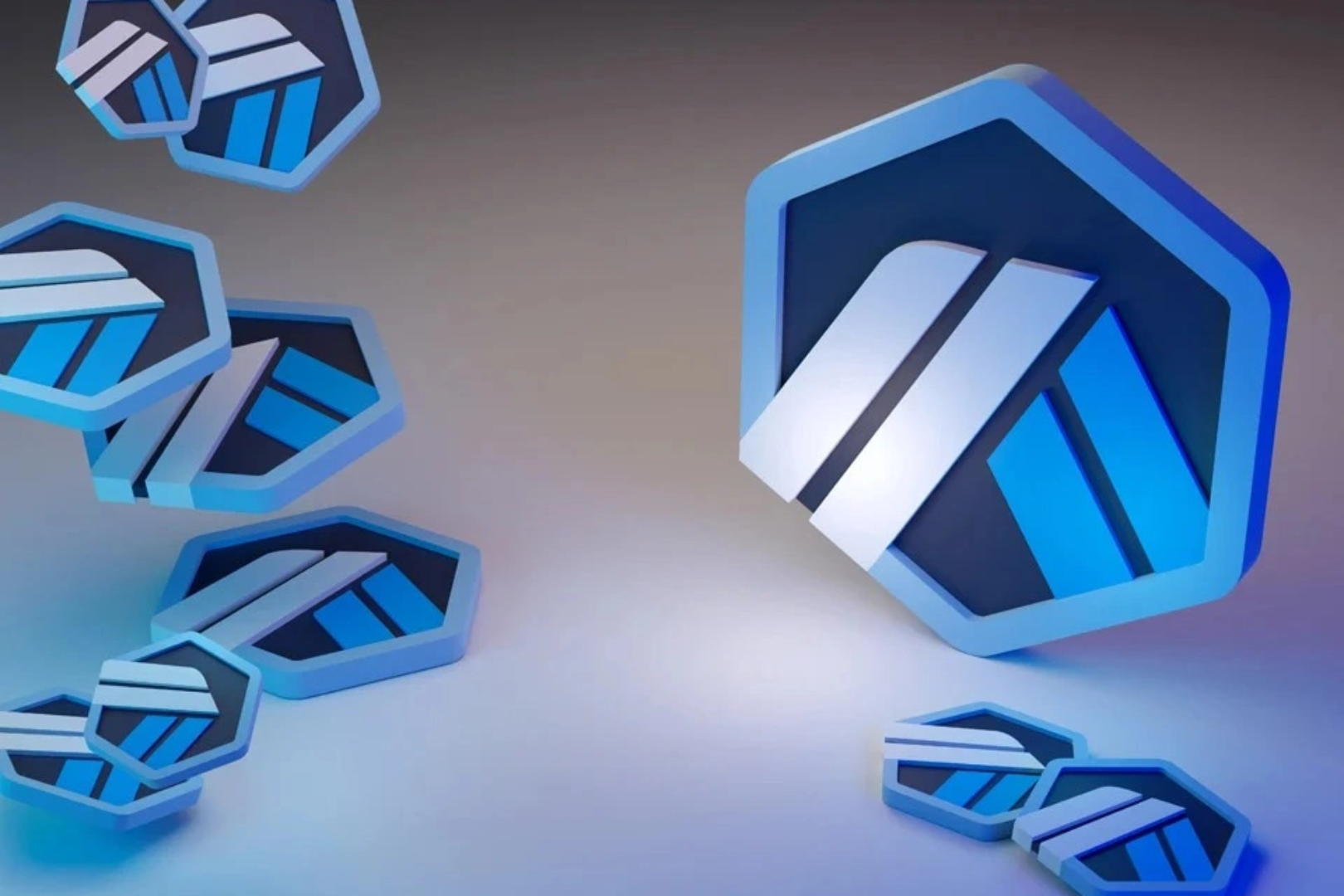
Original author: Castle Labs
Original translation: Saoirse, Foresight News
summary
For many, the ability to enter the realm of real-world assets (RWAs) has become a benchmark for measuring whether cryptocurrencies have achieved mainstream adoption: only when we can connect the on-chain world with traditional finance can cryptocurrencies truly establish their position as an attractive mainstream asset.
What was once envisioned is gradually becoming a reality, with U.S. Treasury bonds, bonds, and even real estate being tokenized and put on the blockchain.
Driven by regulatory clarity and technological maturity, RWA is gaining significant development momentum.
This article focuses on the Arbitrum ecosystem, a Layer 2 solution that has successfully launched multiple projects focused on RWA, with the total locked value (TVL) of RWA assets currently exceeding US$350 million.
This article will provide an overview of RWAs on Arbitrum, the projects and initiatives driving their development, key assets and providers (including case studies), as well as associated risk considerations and future prospects.
Overview of RWA on Arbitrum
The RWA market is booming. Many early cryptocurrency adopters envisioned a scenario where Wall Street elites would use cryptocurrencies. Now, that vision has become a reality, with real-world assets finally being successfully brought online and experiencing widespread adoption.
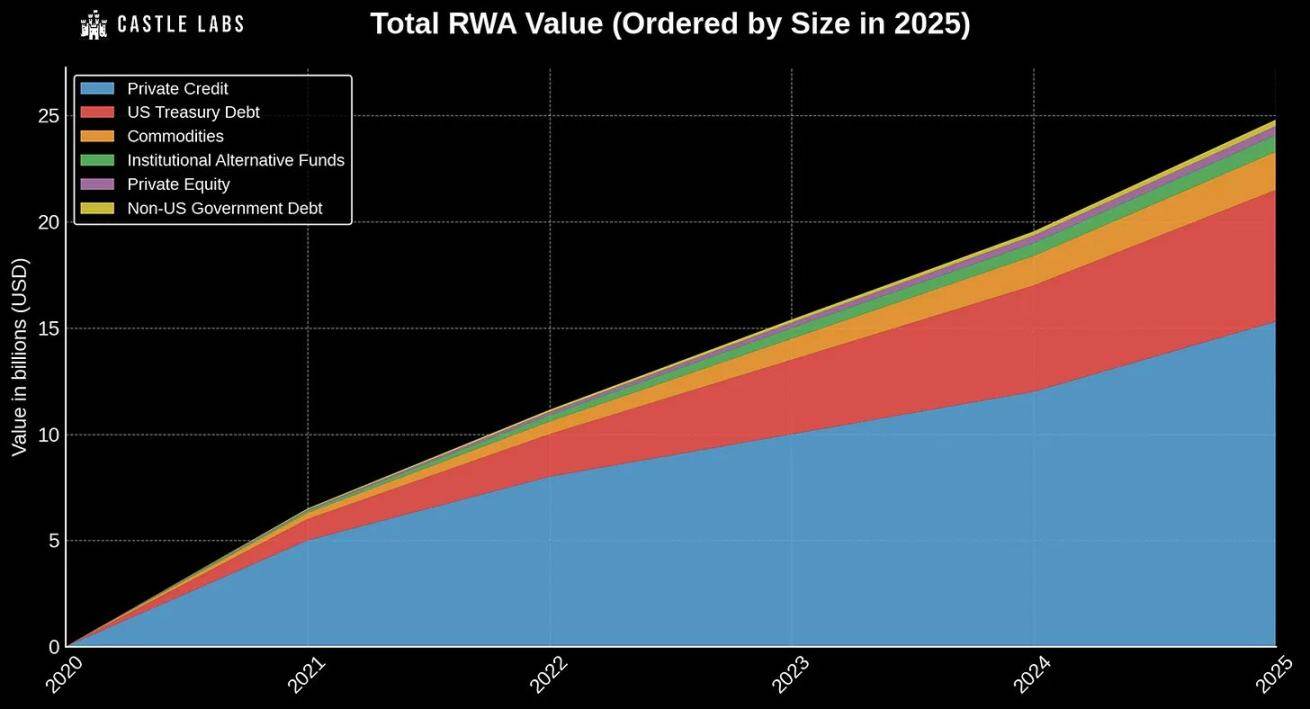
Source: rwa.xyz
Currently, the total value of RWA exceeds $25 billion, broken down as follows:
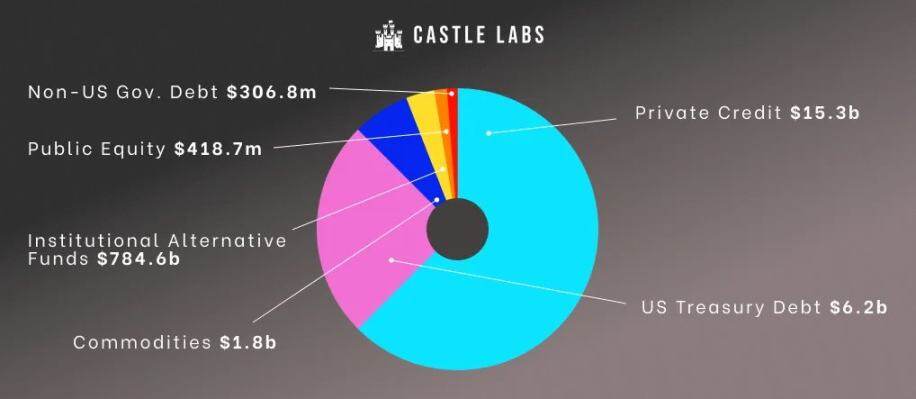
Source: rwa.xyz
- Private credit: $15.3 billion (60%)
- U.S. Treasury bonds: $6.2 billion (26.9%)
- Commodities: $1.8 billion (7.2%)
- Institutional alternative funds: $784 million (3.26%)
- Private equity: $418.7 million (1.71%)
- Non-U.S. government bonds: $306 million (about 1.2%)
The on-chaining of RWA benefits from the combined effect of multiple factors:
- The digital asset regulatory framework is maturing
- Technical infrastructure has achieved production-level reliability
- Institutional interest is rapidly increasing
Cryptocurrencies are gradually being accepted and incorporated into regulatory frameworks, such as Europe’s MiCA and the recently passed GENIUS Act in the United States, which means that these assets are gradually becoming legitimate in the wider financial environment.
At the same time, networks such as Bitcoin and Ethereum have been running stably for more than ten years, fully demonstrating their security, activity and decentralization.
However, due to its inherent characteristics, RWA requires higher security before it can be put on the chain. Therefore, the emergence of L2 is very attractive to institutional investors. Compared with the Ethereum mainnet, they can significantly reduce the cost of on-chain operation by several orders of magnitude.
Among the many second-layer networks, Arbitrum is one of the fastest-growing second-layer solutions in the RWA field.
Why Arbitrum?
- Mature and reliable technology stack
- Trusted Blockspace Neutrality
- One of the largest capital pools in the cryptocurrency space
Arbitrum has a solid technology stack: its focus on technology-driven development, with the launch of technological achievements such as Stylus and Timeboost, makes it a valid alternative to the Ethereum mainnet.
Furthermore, Arbitrum's backend technology is used by projects like HyperliquidX as a cross-chain bridge for USDC, exceeding the capabilities of its ecosystem. This demonstrates Arbitrum's trusted neutrality as a blockchain. Trusted neutrality refers to a blockchain network operating with impartiality, treating all participants equally and without favoring any particular user, application, or outcome.
The importance of credible neutrality:
- Trust: Users and institutions prefer to rely on a platform that doesn’t arbitrarily change its rules or favor one party over another.
- Security: A neutral system is more resistant to the risks of manipulation or centralization.
- Composability: DeFi can thrive when developers can be confident that no protocol gets special treatment.
- Institutional confidence: For RWA, neutrality ensures that tokenized assets are not exposed to hidden risks (such as censorship, biased governance, etc.).
Finally, it is worth mentioning that Arbitrum has the sixth largest funding pool in the field, with assets exceeding US$1.17 billion, and also has one of the most mature stablecoin ecosystems.
RWAs can represent tangible assets and interest-bearing instruments while possessing the programmability and transparency of blockchain systems, bringing new opportunities for institutional investors and decentralized autonomous organizations (DAOs) to diversify investments, stabilize returns, and improve capital efficiency.
What proposals drove this development?
This section briefly reviews the development of RWA in Arbitrum. The initial development of RWA in Arbitrum was jointly driven by the Foundation and the Arbitrum DAO.
Arbitrum DAO’s first foray into the RWA space began with the Stable Treasury Endowment Proposal (STEP), followed by the RWA Innovation Funding Program, the Treasury Management Proposal, and finally STEP 2.
STEP (April 2024)
The proposal aims to deploy over $85 million (35 million ARB) in tokenized real-world assets such as U.S. Treasuries through institutional issuers.
Although the program initially began as a pilot program, several providers were successfully selected after an in-depth analysis of applicants:
- Securitize BUIDL
- Ondo Finance's USDY
- Superstate's USTB
- Mountain Protocol’s USDM
- OpenEden's TBill
- Backed by bib 01
The criteria for screening applicants are as follows:
- No investment restrictions
- Companies with a clear organizational structure and seamless divisions
- Significant assets under management, multiple ISIN exposures, and an experienced team
- Use public or decentralized tools and networks (rather than relying solely on proprietary tools and networks)
- Avoid companies with additional layers of decentralized governance
- Have sufficient and detailed documentation
To ensure coverage extends beyond the aforementioned list, STEP also plans to invest 1% of the DAO treasury annually in tokenized real-world assets over the next five years. This initiative also provides a practical opportunity to gain deeper understanding of the RWA space and the balance between ecosystem development and principal protection. Future iterations are expected to focus on one of these goals.
The STEP program was a huge success, generating $600,000 in interest income for Arbitrum DAO in less than a year.
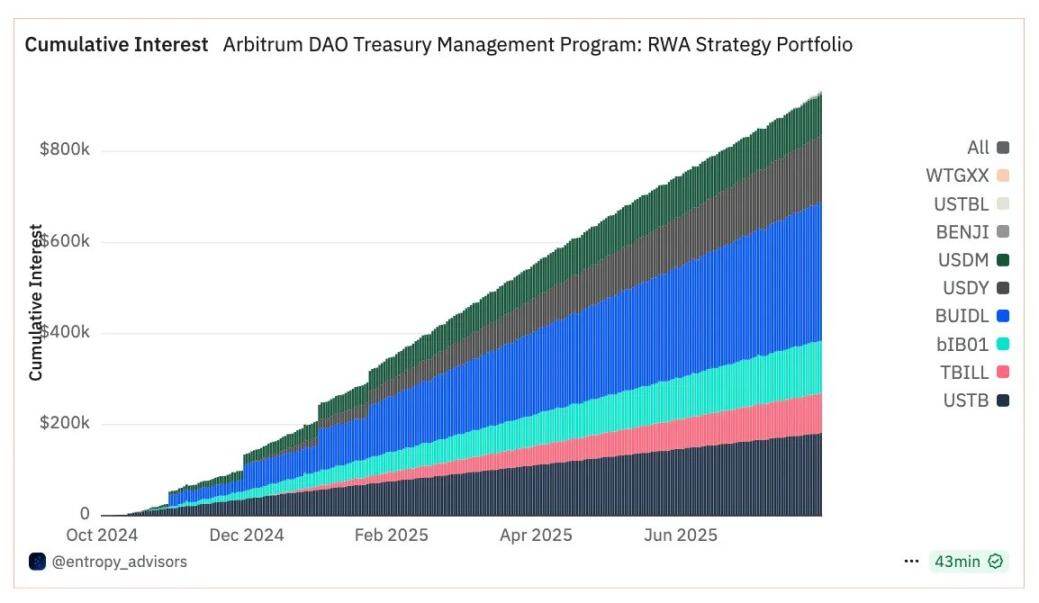
The following are the cumulative amounts calculated by month:
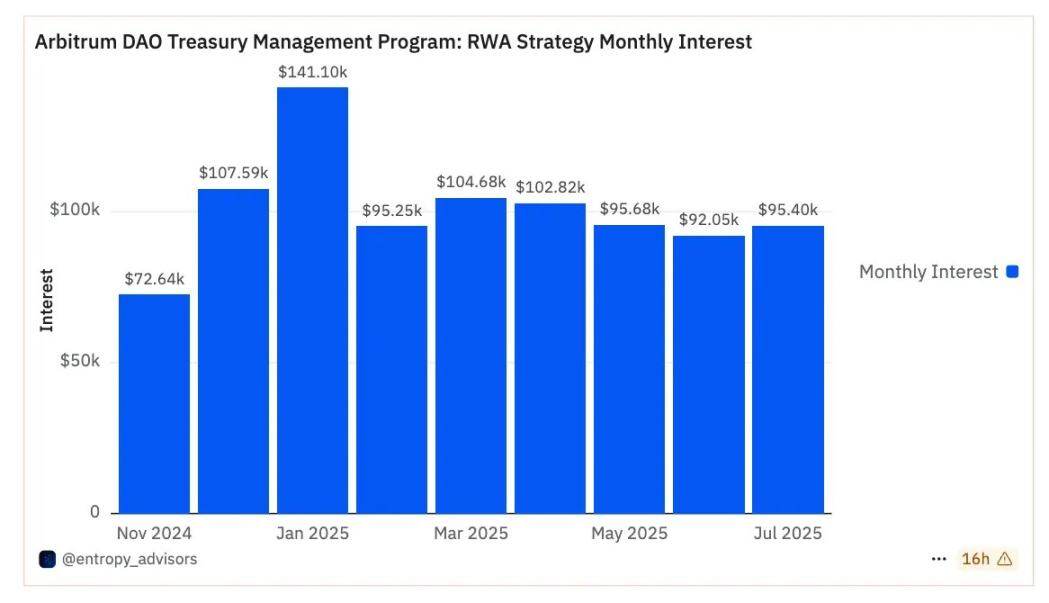
What makes STEP unique is that it follows clear principles when working with institutional service providers:
- Directly evaluate and screen interest-bearing stable assets without the need for intermediaries
- Using the Request for Proposal (RFP) model, the parties to the agreement can submit product applications and receive review
- Institutional participants apply directly in the decentralized forum, and the program aims to create sustainable benefits for DAOs
RWAIG Grant Program (June 2024)
The Arbitrum Foundation is funding a series of innovation grants (RWAIG), a two-month pilot program running from June to August 2024 to support RWA integration, analysis, and research work within Arbitrum with a budget of ARB 300,000.
The main objectives of these grants are to:
- Significantly increase the activity of RWA within Arbitrum, take a leading position in the competition, and achieve "future growth guarantee for the platform"
- Discover how to invest DAO treasury funds into RWAs and how to enable on-chain tokenization on Arbitrum
- Wider integration of RWA assets and tools into existing ecosystem applications such as GMX, Aave, and Pendle
The program ultimately funded eight different projects:
- RWA Research: Popularizing Field Knowledge to Users
- PYOR: RWA Analytics Dashboard
- Mystic Finance: A lending market that allows users to borrow stablecoins using RWA assets as collateral.
- Jia: Converting SME accounts receivable into tokenized assets
- Truflation: Provides real-time inflation data
- Backed Finance: Creating structured products that track securities
- Infinfty: Developing the ERC-6651 RWA token to track the entire lifecycle of product sourcing, performance, ownership, and environmental impact
Treasury Management (December 2024)
At the end of 2024, a treasury management proposal emerged to complement the early work of STEP. This proposal focused on generating passive income through on-chain strategies using ARB tokens, rather than leaving tokens in the treasury idle.
Its objectives include:
- Asset Management: Manage 25 million ARB tokens and generate income on the chain
- Stablecoin Conversion: Simplify the process of converting ARB assets into stablecoins, minimizing slippage and market impact
- Stablecoin liquidity deployment: 15 million ARB will be converted into stablecoins and invested in low-risk interest-earning strategies to cover DAO expenses or service provider fees.
- Diversification and stability: Focus on risk-adjusted returns while ensuring capital security
This strategy is divided into two directions:
- Treasury: Reserve 10 million ARB for pure ARB strategy, and convert 15 million ARB into stablecoins as the DAO's "current account"
- Growth: Allocating 7,500 ETH to Decentralized Finance (DeFi)
STEP 2 (January 2025)
Inspired by the initial success of STEP, the STEP 2 proposal was approved, with an additional investment of 35 million ARB (approximately US$15.7 million).
After carefully reviewing more than 50 applications, the STEP Committee decided to allocate assets in the following proportions:
- WisdomTree WTGXX: 30%
- Spiko USTBL: 35%
- Franklin Templeton FOBXX (BENJI): 35%
The importance of the initiative is also reflected in its recognition by the DAO.
STEP 2 was passed with an absolute majority, with nearly 89% of participants supporting it, 11% abstaining, and only 0.01% opposing it.
Together, these projects and initiatives have driven the growth of real-world assets on Arbitrum’s blockchain, increasing its total value locked (TVL) from virtually zero to over $70 million in less than a year.
So what is the current situation?
What is the RWA landscape on Arbitrum?
The next section will use on-chain data to delve deeper into the growth of RWA assets, asset providers, and RWA on Arbitrum.
Growth of RWAs on Arbitrum
With its low-cost, high-throughput architecture and trusted neutrality, Arbitrum is rapidly building an ecosystem of issuers, infrastructure providers, and incentive programs to drive RWA on-chain at scale.
Although Arbitrum initially focused on DeFi infrastructure, DEX, lending protocols, and yield aggregators, the idea of bringing off-chain assets on-chain began to attract attention after early trials of tokenized U.S. Treasury bonds on Ethereum in 2022.
Currently, Arbitrum’s RWA market capitalization is approaching $350 million, with over 129 assets tokenized. While this figure is impressive, it only represents approximately 1.39% of the total RWA asset market capitalization, indicating strong growth potential in the future.
While predictions vary widely, several estimates for the growth of the on-chain RWA space include:
- $16 trillion by 2030 (10% of global GDP)
- $30 trillion by 2034
Under the first forecast scenario, the sector is expected to grow 40-fold over the next five years.
As one of the most mature on-chain RWA networks, this will give Arbitrum a significant competitive advantage.
The growth of RWA on Arbitrum
In 2024 alone, Arbitrum’s total value locked (TVL) grew from almost zero to nearly $85 million by the end of the year.
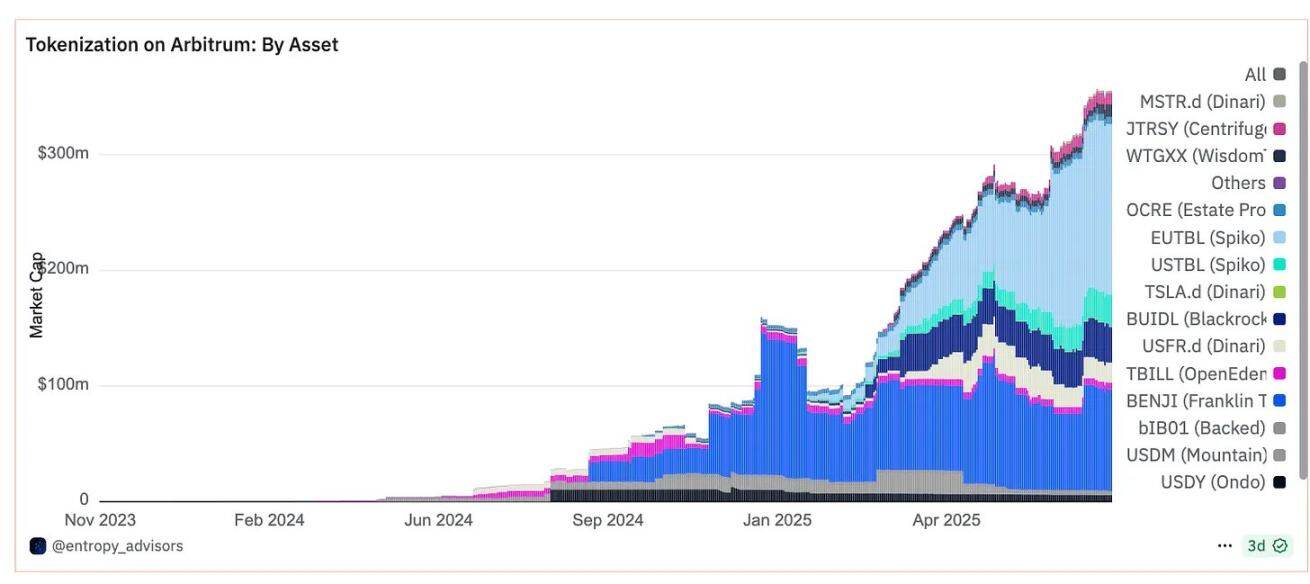
This growth journey can be divided into three phases, closely related to the key initiatives mentioned above:
- Early Growth Phase (Q1 2024): Arbitrum’s total RWA locked value surged from almost zero to over $5 million, showing initial momentum.
- Substantial Growth Phase (Q2 2024): In the first half of 2024, the total locked value increased from approximately US$20 million to approximately US$70 million, coinciding with the capital allocation time of STEP 1.
- Continuous Expansion Phase: With the increase of DAO treasury allocation (STEP 2) and the addition of new RWA issuers (such as Spiko, WisdomTree, and BlackRock), continued growth will continue in 2025.
This development is also reflected in the types of assets supported on the chain. In 2024, most RWAs were still US Treasury bonds. Over time, the asset types have continued to expand, and new types have been included.
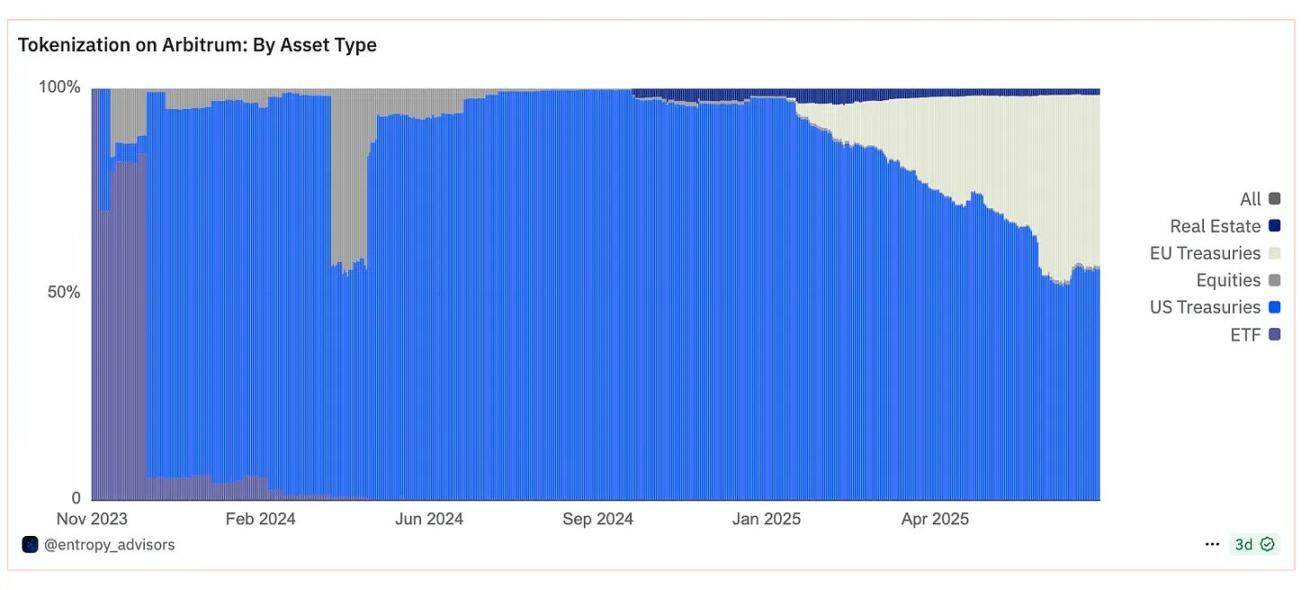
While US Treasuries still make up the majority of asset classes ($197 million), EU government bonds are a close second ($150 million). Alternative assets such as real estate, stocks, and ETFs are also gaining traction.
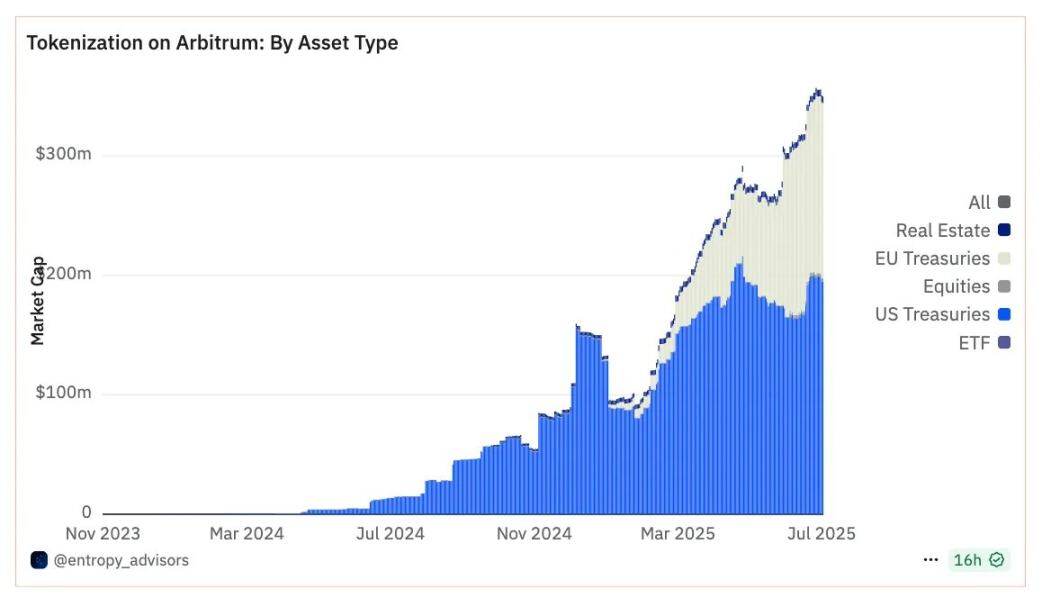
RWA Assets and Providers
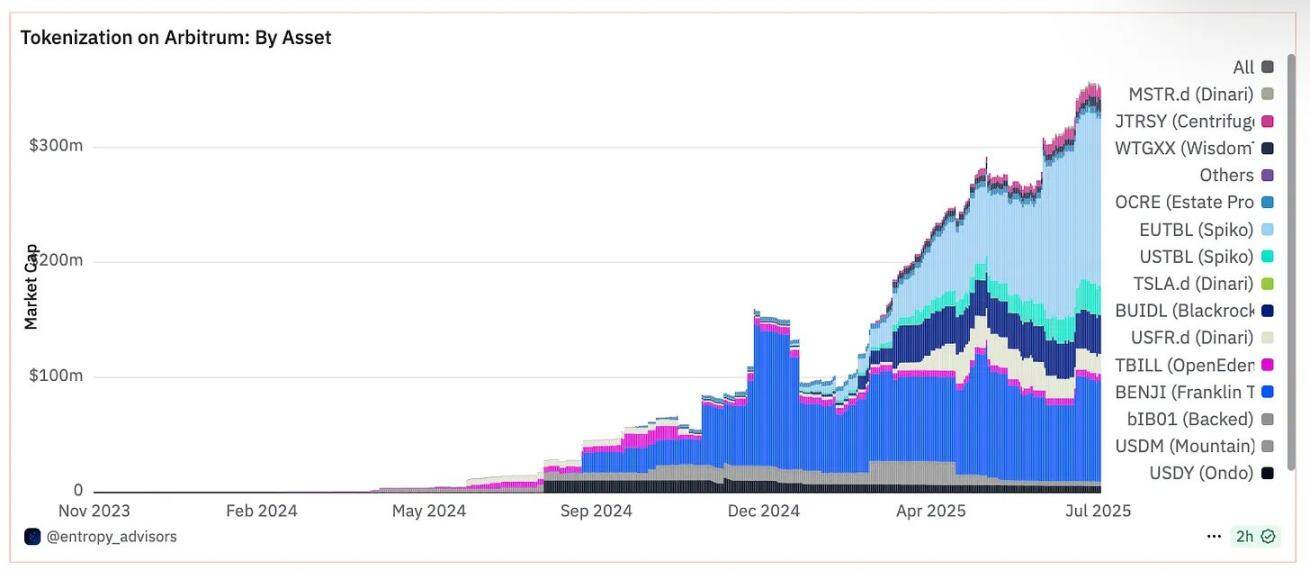
This section takes a deeper dive into these asset classes, focusing on the top ten RWA products by total value and categorizing them by issuer.
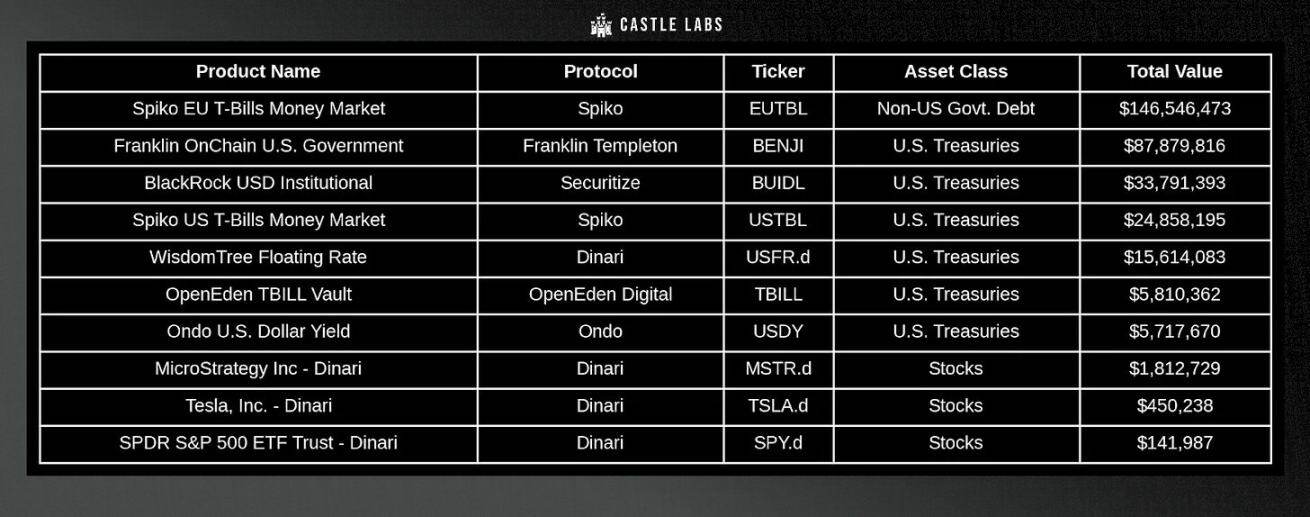
Spiko
Spiko has built an on-chain security token issuance and distribution platform.
The platform, licensed by the French Financial Markets Autorité (AMF), has launched two money market funds:
- Spiko Euro (EUTBL)
- Spiko USD (USTBL)
These funds, backed by a portfolio of short-term government bonds, offer returns similar to the central bank’s risk-free rate. Currently, they are among the most widely used products, with EUTBIL leading the list with $146 million in total value, and USTBL fourth with $24.8 million, further demonstrating that short-term government bonds are the most widely used asset on-chain.
Franklin Templeton
Franklin Templeton is a well-known investment management company listed on the New York Stock Exchange (NYSE).
To bring tokenized mutual funds onto the blockchain, the company launched the BENJI mobile app, whose proprietary record-keeping system supports tokenized securities and cryptocurrencies.
Each BENJI token represents a share of the U.S. Government Money Market Fund (FOBXX) on the Franklin Chain. Currently, BENJI is the second largest RWA product on Arbitrum, with a value of over $87 million.
Securitize
Securitize is a platform that provides institutional investors with access to tokenized securities.
On Arbitrum, the platform offers BlackRock’s US dollar institutional digital liquidity fund, BUIDL.
This is a short-term Treasury bond tokenized product that focuses on providing USD returns on-chain, with a total value exceeding US$33 million.
Dinari
Dinari allows the creation of tokenized stocks, ETFs, indices, etc., which are called "dShares" and maintain a 1:1 full endorsement relationship with the underlying assets.
Dinari has launched several products on Arbitrum:
- WisdomTree Floating Rate Treasury Bond Fund (USFR.d): Provides low-cost investment in U.S. government floating rate bonds with a total value of over $15 million.
- Tokenized MicroStrategy stock (MSTR.d): $1.8 million.
- Tokenized Tesla stock (TSLA.d): Total value $450,000.
- Tokenized S&P 500 ETF Trust (SPY.d): An index composed of S&P 500 companies with a size of approximately $141,000.
These assets highlight the potential of stocks and indices, but they still make up a small portion of Arbitrum.
OpenEden
OpenEden provides access to tokenized U.S. securities and other products. The platform is licensed by the Bermuda Monetary Authority, holds a digital asset license, and has an investment-grade rating from Moody's.
Currently, the platform is the most important issuer of tokenized U.S. Treasury bonds in Europe and Asia. OpenEden has launched the TBILL fund pool, where users can invest in short-term U.S. Treasury bonds.
Currently, deposits in the pool exceed $5.8 million.
Ondo
Ondo provides investors with access to institutional financial products.
On Arbitrum, its USDY product has initially received a good response, with a total value of US$5.7 million.
USDY is an interest-bearing stablecoin backed by U.S. Treasuries, with an annualized yield of approximately 4.29%.
While Arbitrum has a rich portfolio of products and assets, the RWA ecosystem is still in its early stages.
Its future development will depend on:
- Chain-level asset expansion to meet a wider range of needs
- Strategically focus on RWA as an area of strength for Arbitrum
- Collaboration between Arbitrum Alliance Entities (AAEs)
- Institutional promotion at the business development level
Future Outlook
The initial providers established in STEP 1 were supplemented by a new batch of providers during STEP 2, enriching the variety of assets and products on Arbitrum.
Based on the current growth rate of Arbitrum’s total RWA value, we can make the following predictions:
- Forming a billion-dollar RWA ecosystem
- Inclusion of more asset classes (private credit, real estate, interest-bearing stablecoins, etc.)
- Achieve deeper interoperability of these assets across networks
Despite some progress, Arbitrum still has significant room for growth to solidify its position in this niche. In fact, Arbitrum ranks only seventh in the network rankings by total RWA asset value. Currently, its $350 million in RWA total value locked (TVL) represents a negligible 1.39% of the total market capitalization of on-chain RWA assets.

To compete with these networks, Arbitrum needs to explore more opportunities and expand into areas such as private credit issuance products, bonds, precious metals such as gold and silver, and stocks.
Given Entropy’s deep involvement in treasury management and RWA-related matters on Arbitrum, we asked Matt for his thoughts on the future development of RWA on Arbitrum. Here are his thoughts:
“Today, a core focus for many RWA issuers is on reducing the operational costs associated with issuance and transfer, but there is still a long way to go to prove this at scale. Nevertheless, the next major breakthrough for RWAs on Arbitrum will be further improving composability.
This isn't just about adding more asset classes or introducing new issuers; that's just the first step. The real breakthrough lies in ensuring these assets integrate with the more efficient on-chain infrastructure the industry has built over the past decade: exchanges, lending protocols, index tools, pool optimization tools, and all the innovations that may emerge in the future. The ultimate goal is open, permissionless transferability, making RWAs as composable as native crypto assets. We're not there yet (and it's an ambitious goal given current regulatory realities), but this is our North Star.
It's encouraging to see industry giants like Franklin and WisdomTree issuing their own tokens. This is true institutional participation, and a trend I hope to see continue to grow. If we can achieve a point where user activities related to RWAs (such as trading and lending) can truly take place on-chain—even if these activities are abstracted through permissioned channels based on Arbitrum—that will open up completely new possibilities."
We wholeheartedly agree with Matt's perspective, particularly regarding the composability and accessibility of these assets. Currently, the potential for these assets to be used on-chain is only just beginning to emerge. We anticipate that in the near future, treasuries, bonds, stocks, and commodities will not only be tokenized on-chain but also integrated into the various application scenarios of the current DeFi infrastructure.
From a research methodology perspective, it is important to note that in this RWA-focused report, we did not include stablecoins in our analysis, as the core purpose of the report is to focus on the various assets currently available on the Arbitrum platform.
Last but not least, in conjunction with this analysis, it is necessary to mention the relevant risks and precautions.
Risk and Foresight Considerations
- Disconnection between tokens and the ecosystem: The growth of real RWA does not directly translate into increased value for ARB tokens.
- Asset concentration risk: Short-term government bonds still account for a very high proportion of the total value locked (TVL) of RWAs, which highlights the need to diversify allocations into multiple asset classes such as private credit, corporate bonds, and real estate.
- Regulatory dynamics risk: Although the regulatory environment for cryptocurrencies is constantly improving and gradually moving towards legalization, the compliance framework for tokenized securities is still in its development stage, and institutional issuance has higher requirements for regulatory clarity and cross-jurisdictional coordination.
The expansion of asset issuers and the on-chain expansion of RWA categories such as private credit and real estate are expected to drive the total value locked (TVL) of the Arbitrum ecosystem to nearly $1 billion by the end of the year.
As the Treasury Management Plan and STEP 2 progress, we expect to gain more information and insights that will not only further shed light on the implementation results of the above plans, but also provide reference for future decisions and actions.
in conclusion
Arbitrum’s RWA total locked value (TVL) grew from nearly zero to $350 million in just over a year.
The STEP program and a series of DAO-led initiatives have been crucial in driving early growth, leading to the launch of a diverse range of institutional-grade products on Arbitrum, including short-term treasury bonds, money market funds, and tokenized stocks.
The successive entry of institutions such as Franklin Templeton and WisdomTree has further consolidated Arbitrum's core position as a "reliable, neutral and low-cost network" in the institutional-level DeFi field.
But this process has only just begun.
In addition to the risks and issues mentioned above, Arbitrum will face a number of strategic opportunities in the coming months.
This includes expanding into RWA categories that have not yet been adequately covered, such as private credit, real estate, and commodities. More importantly, it is necessary to enhance the composability of these new products and achieve deep integration with Arbitrum’s core infrastructure components (decentralized exchanges, lending protocols, funding pools, etc.).
As the ongoing STEP 2 and treasury management initiatives continue to gain momentum and provide practical experience, collaboration between DAOs, alliance entities, and institutional participants will be key to Arbitrum’s long-term leadership in the RWA space.

